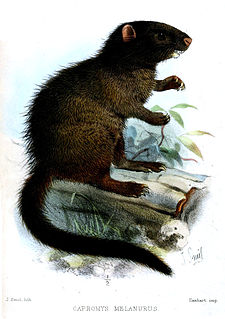Early modern human (EMH) or anatomically modern human (AMH) are terms used to distinguish Homo sapiens that are anatomically consistent with the range of phenotypes seen in contemporary humans from extinct archaic human species. This distinction is useful especially for times and regions where anatomically modern and archaic humans co-existed, for example, in Paleolithic Europe. Among the oldest known remains of Homo sapiens are from Omo-Kibish I, dating to about 196,000 years ago, Florisbad, dating to 259,000 years ago, and Jebel Irhoud, dated about 300,000 years ago.

The Pieridae are a large family of butterflies with about 76 genera containing about 1,100 species, mostly from tropical Africa and tropical Asia with some varieties in the more northern regions of North America. Most pierid butterflies are white, yellow, or orange in coloration, often with black spots. The pigments that give the distinct coloring to these butterflies are derived from waste products in the body and are a characteristic of this family. The family was created by William John Swainson in 1820.

The island fox is a small fox that is native to six of the eight Channel Islands of California. There are six subspecies, each unique to the island it lives on, reflecting its evolutionary history. Island foxes are generally docile, show little fear of humans, and are easily tamed. Island foxes played an important role in the spiritual lives of native Channel Islanders. Island foxes have been likely semi-domesticated as pets, used as pelts, or for other functions, like pest control.

Anthocharis cardamines, the orange tip, is a butterfly in the family Pieridae, which contains 1100 species of butterfly. A. cardamines is mainly found throughout Europe and temperate Asia (Palearctic) The males feature wings with a signature orange pigmentation, which is the origin of A. cardamines' common name.

Anthocharis belia, the Moroccan orange tip, is a butterfly of the family Pieridae. It is found in northwestern Africa. The length of the forewings is 18–20 millimetres (0.7–0.8 in).

Anthocharis cethura, the desert orangetip or Felder's orangetip, is a species of butterfly in the subfamily Pierinae. It is native to the southwestern United States and northern Mexico, where it lives on hills and ridges in rocky desert habitat.

Anthocharis julia, the southern Rocky Mountain orangetip, is a butterfly found in the southern Rocky Mountains on the eastern side of the range. Their caterpillars feed on rock cress (Arabis) species.
Mycobacterium avium subspecies paratuberculosis (MAP) is an obligate pathogenic bacterium in the genus Mycobacterium. It is often abbreviated M. paratuberculosis or M. avium ssp. paratuberculosis. It is the causative agent of Johne's disease, which affects ruminants such as cattle, and suspected causative agent in human Crohn's disease and rheumatoid arthritis. The type strain is ATCC 19698.

Anthocharis stella, the stella orangetip, is a species of butterfly found mainly in the Rocky Mountains in the United States where its caterpillar feeds on different kinds of rock cress. It has several subspecies.
Anthocharis stella browningi, the Utah Stella orangetip, is a subspecies of the Stella orangetip mainly found in the southern American Rocky Mountains especially in the drier areas.

The Pierinae are a large subfamily of pierid butterflies. The subfamily is one of several clades of butterflies often referred to as the whites. It includes the following species :

The tribe Anthocharini is one of the subdivisions of the insect order Lepidoptera, which includes the moths and butterflies. It is a further subdivision of the butterfly family Pieridae and subfamily Pierinae; formerly it was considered a subfamily on its own, Anthocharinae. This tribe includes many, but not all, of the orangetip butterflies.

Anthocharis is a Holarctic genus of the butterfly tribe Anthocharini, in the family Pieridae. These are typically small, white-hued butterflies that have colorful marks just inside the tips of the forewings. The tip colors are usually a red-orange hue, hence the name "orange tip". The larvae of these butterfly often consume cruciferous plants containing chemicals called glucosinolates. This genus is characterized by two of the five subcostal veins branching off before the apex of the cell, by the upper radial being only little united with the subcostal, and by the central discocellular being rather long. In all the species the males have at least the apical portion of the forewing orange red or yellow. Only one species inhabits also the northern districts of the Palearctic region, all the others are found in the south of the Palearctic region, also some species occur in North America, but not one species extends into the tropics. The Anthocharis species have only one brood. The butterflies occur in spring.

Mysateles is a genus of rodent in the family Capromyidae. The genus is restricted to Cuba.

The ornate shrew, is a species of mammal in the family Soricidae (shrews). It is endemic to western North America, ranging from Northern California in the United States to Baja California in Mexico. Eight subspecies are known, including the extinct tule shrew, known only from four specimens collected in 1905, and the Suisun ornate shrew, a species of conservation concern in California. Through skull morphology research and genetic testing on Ornate shrew populations, it has been shown that there are three main genetic subdivisions: The Southern, Central and Northern. These three genetic subdivisions of Ornate shrew arose from populations of Ornate shrews getting geographically isolated from other populations.

Metergoline is a psychoactive drug of the ergoline chemical class which acts as a ligand for various serotonin and dopamine receptors.
Cerebral blood volume is the blood volume in a given amount of brain tissue.
Hedbergia longiflora, formerly Bartsia longiflora, is a species of flowering plants in the family Orobanchaceae.











